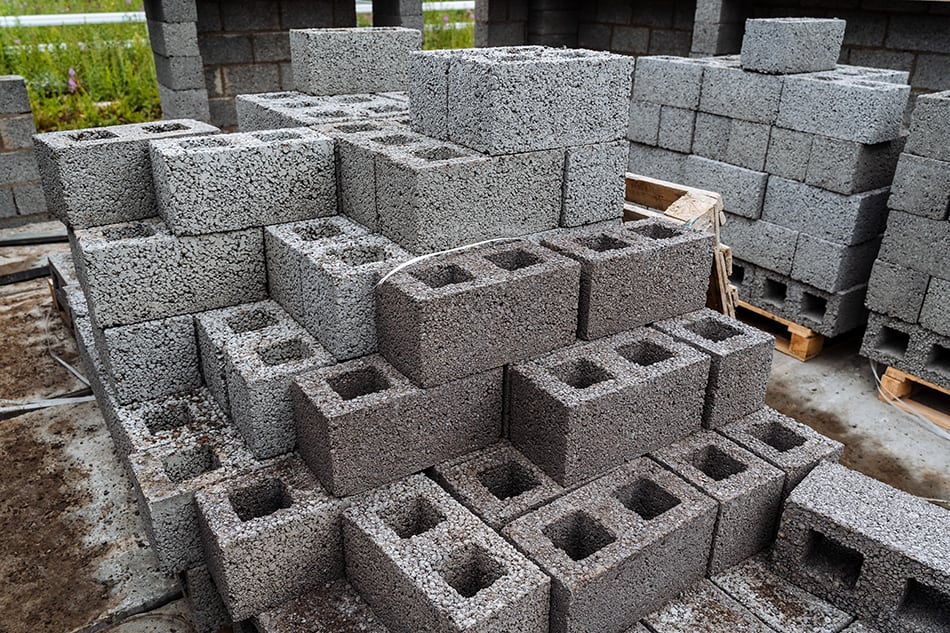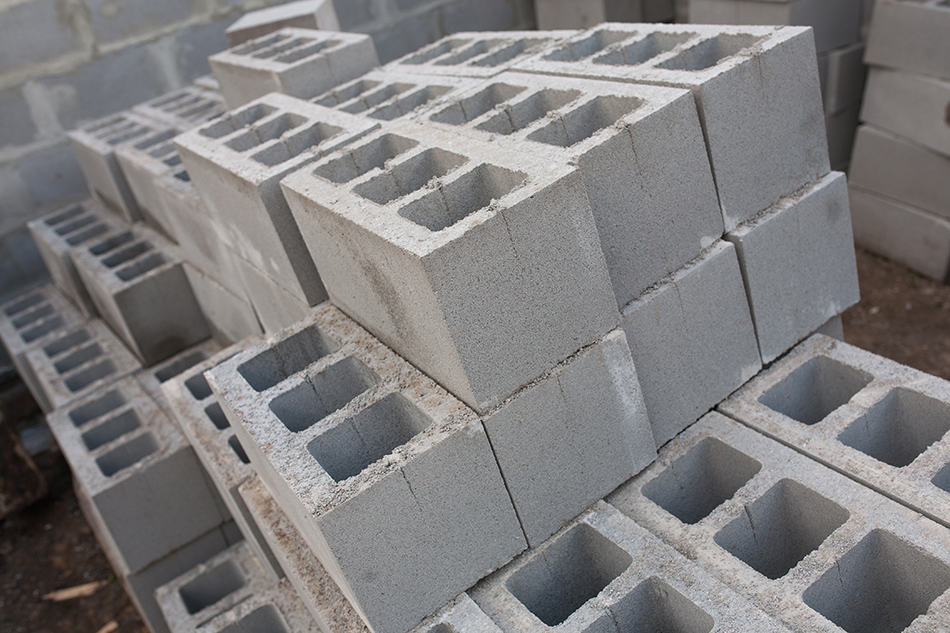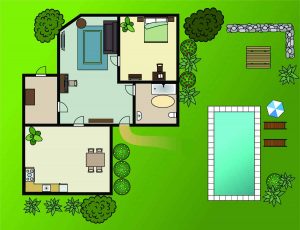What are cinder blocks? They are just like concrete blocks, but the difference is that in concrete blocks, fine gravel takes a large percent of the content while coal cinder takes a large percent of the content.
Before now, cinder blocks were more popular and commonly used for construction projects like garden walls, fire pits, benches, and lots more, but now, cinder block has been replaced by concrete blocks because of the low production and availability of cinder blocks.
Cinder blocks are lighter in weight when compared to concrete blocks, and they are therefore not considered strong enough to bear loads, but they may be replaced by concrete blocks in fences and walls.
The dimensions of a standard cinder block are 8 inches high, 8 inches deep, and 16 inches long. There may be variations in size between cinder blocks, ranging from fractions to an entire inch.
In this guide, we will explore the different dimensions of cinder blocks and how you can choose the correct type of cinder block.
Types of Cinder Blocks
here are three 3 types of cinder blocks: standard, lightweight, and architectural.
Standard cinder blocks are the most commonly used and are known for their strength and durability. They are made from a mix of cement, aggregate, and water, and are typically used for load-bearing walls and general construction purposes.
Lightweight cinder blocks are made with lighter aggregates, such as expanded clay or shale. These blocks provide better thermal insulation and are easier to handle due to their reduced weight. They are ideal for non-load-bearing walls and projects where insulation is a priority.
Architectural cinder blocks feature unique designs and textures for aesthetic purposes. These blocks can have decorative elements, such as patterns or colored aggregates, to enhance a building’s visual appeal. While they can still provide structural support, their primary focus is on creating visually striking walls and facades.
Dimensions of Cinder Blocks
Standard Cinder Block Dimensions
Cinder blocks come in nominal and actual dimensions. Nominal dimensions are the advertised size, usually rounded up to the nearest whole number. Actual dimensions are slightly smaller, accounting for the mortar joint when used in construction. Standard cinder blocks are typically 8 inches high, 8 inches deep, and 16 inches long.
The real dimensions for an 8 by 8 by 16 inches are actually 7 5/8 by 7 5/8 by 15 5/8. The dimension is done this way in order to allow the mortal that goes in between them, which is always 3/8 inches thick. It also makes it easier for mansions to estimate how many blocks will be needed.
Non-Standard Cinder Block Dimensions
In addition to standard sizes, cinder blocks come in various non-standard dimensions. Half cinder blocks measure 8 inches high, 8 inches deep, and 8 inches long. Jumbo cinder blocks are larger, usually 8 inches high, 12 inches deep, and 24 inches long. Other specialty sizes are also available to suit specific project requirements.
Corner Blocks and Bullnose Blocks
Corner blocks and bullnose blocks serve particular purposes in construction. Corner blocks have a unique shape to create a clean, finished look at the edges of walls. Bullnose blocks feature rounded edges for a smoo
Major Dimensions of Cinder Blocks
The dimensions of the cinder block are majorly divided into 5 dimensions. These are the 4 inches dimension, the 6 inches dimensions, the 8 inches dimension, the 10 inches, and the 12 inches dimensions.
4-inch Cinder Block
| 4-inch Cinder Block | Cinder Block Sizes |
|---|---|
| Solid Pier | 3 5/8 inches by 7 5/8 inches by 3 5/8 inches |
| Solid Pier | 7 5/8 inches by 7 5/8 inches by 3 5/8 inches |
| Solid Pier | 7 5/8 inches by 11 5/8 inches by 3 5/8 inches |
| Solid Pier | 3 5/8 inches by 15 5/8 inches by 3 5/8 inches |
| Solid Pier | 7 5/8 inches by 15 5/8 inches by 3 5/8 inches |
| Hollow Pier | 3 5/8 inches by 15 5/8 inches by 3 5/8 inches |
| Hollow Pier | 7 5/8 inches by 15 5/8 inches by 3 5/8 inches |
| Hollow Pier | 7 5/8 inches by 17 5/8 inches by 3 5/8 inches |
The four inches dimension cinder block is called this because they generally have a width of 4 inches. It is further divided into 8 different dimensions. This set of cinder blocks have different dimensions. One of the dimensions in this category is the 3 5/8 inches height by 7 5/8 inches length by 3 5/8 inches width. This is one of the nominal sizes of the solid pier. Another dimension of solid pier cinder block is one with 7 5/8 inches height by 7 5/8 inches length by 3 5/8 inches width. Also, there is a solid pier of dimensions 7 5/8 inches by 11 5/8 inches by 3 5/8 inches. There is another type of pier cinder block with the dimensions of 3 5/8 inches by 15 5/8 inches by 3 5/8 inches. The last solid pier in the 4 inches category has a dimension of 7 5/8 inches by 15 5/8 inches by 3 5/8 inches.
Still, in the 4 inches category, we have different dimensions of hollow pier cinder blocks. The first one in this category is the one with dimensions 3 5/8 inches by 15 5/8 inches by 3 5/8 inches. We also have another size of the hollow pier cinder block, which has dimensions 7 5/8 inches by 15 5/8 inches by 3 5/8 inches. Similar to this is a cinder block with dimensions 7 5/8 inches by 17 5/8 inches by 3 5/8 inches.
6-inch Cinder Block
| 6-inch Cinder Block | Cinder Block Sizes |
|---|---|
| Hollow Stretcher | 3 5/8 inches by 15 5/8 inches by 5 5/8 inches |
| Hollow Corner Sash | 7 5/8 inches by 7 5/8 inches by 5 6/8 inches |
| Solid Corner Sash | 7 5/8 inches by 15 5/8 inches by 5 5/8 inches |
| Solid Pier | 7 5/8 inches by 17 5/8 inches by 5 5/8 inches |
Moving to the 6 inches cinder block, we have several different dimensions in the 6 inches category. The first dimension is the 3 5/8 inches by 15 5/8 inches by 5 5/8 inches.
The cinder blocks in this dimension have different names assigned to them. These names depend on the type of design that can be found on the body of the cinder block and what it is used for. We have the hollow stretcher, the hollow corner sash, the solid corner sash, and the solid pier in this category.
Another dimension of the cinder block is the one with a height of 7 5/8 inches, a length of 7 5/8 inches, and a width of 5 6/8 inches. Another dimension in the 6 inches category is the 7 5/8 inches by 15 5/8 inches by 5 5/8 inches. This also has about 4 different designs under it, and they serve several purposes in construction. We also have the 7 5/8 inches by 17 5/8 inches by 5 5/8 inches.
8-inch Cinder Block
| 8-inch Cinder Block | Cinder Block Sizes |
|---|---|
| Hollow stretcher, Hollow corner sash | 3 5/8 inches by 15 5/8 inches by 7 5/8 inches |
| Hollow Corner Half | 7 5/8 inches by 7 5/8 inches by 7 5/8 inches |
| 8-inch Type | 7 5/8 inches by 15 5/8 inches by 7 5/8 inches |
| 8-inch Type | 7 5/8 inches by 17 5/8 inches by 7 5/8 inches |
The 8 inches category also has about 4 different dimensions under it. We have the hollow stretcher and hollow corner sash of dimensions 3 5/8 inches by 15 5/8 inches by 7 5/8 inches. Also, there is the hollow corner sash half that has a dimension of 7 5/8 inches by 7 5/8 inches by 7 5/8 inches. Also in the 8 inches category is the 7 5/8 inches by 15 5/8 inches by 7 5/8 inches dimension. The last cinder block in the 8 inches category is the width dimension of 7 5/8 inches by 17 5/8 inches by 7 5/8 inches.
10-inch Cinder Block
| 10-inch Cinder Block | Cinder Block Sizes |
|---|---|
| Solid pier, the solid corner sash, the hollow stretcher, the hollow pier, and the hollow corner sash | 3 5/8 inches by 15 5/8 inches by 9 5/8 inches |
| 10-inch Type 1 | 7 5/8 inches by 15 5/8 inches by 9 5/8 inches |
| 10-inch Type 2 | 7 5/8 inches by 17 5/8 inches by 9 5/8 inches |
| 10-inch Type 3 | 7 5/8 inches by 7 5/8 inches by 9 5/8 inches |
In the 10 inches category are the solid pier, the solid corner sash, the hollow stretcher, the hollow pier, and the hollow corner sash with a dimension of 3 5/8 inches by 15 5/8 inches by 9 5/8 inches.
Other dimensions in the 10 inches category are the 7 5/8 inches by 15 5/8 inches by 9 5/8 inches dimension, 7 5/8 inches by 17 5/8 inches by 9 5/8 inches dimension, 7 5/8 inches by 7 5/8 inches by 9 5/8 inches.
12-inch Cinder Block
| 12-inch Cinder Block | Cinder Block Sizes |
|---|---|
| 12-inch Type 1 | 3 5/8 inches by 15 5/8 inches by 11 5/8 inches |
| 12-inch Type 2 | 7 5/8 inches by 15 5/8 inches by 11 5/8 inches |
| 12-inch Type 3 | 7 5/8 inches by 7 5/8 inches by 11 5/8 |
Lastly, there is the solid pier, solid corner sash, hollow corner sash, hollow double sash, hollow pier, hollow stretcher. The 12 inches category has several dimensions under it. Among these are the 3 5/8 inches by 15 5/8 inches by 11 5/8 inches dimension, the 7 5/8 inches by 15 5/8 inches by 11 5/8 inches dimension, and the 7 5/8 inches by 7 5/8 inches by 11 5/8 inches dimension.
When getting a cinder block, the dimensions might not be written in the manner in which it was written above, but it might be written in whole numbers. It is important to take into account the space for mortar that is between the blocks when calculating the number of cinder blocks you want to use.
Cinder Block Load Bearing Capacity
According to the standards set by the American Society for Testing and Materials, all standard concrete blocks must be able to support at least 1,700 pounds (771 kilograms) of weight per square inch.
The load-bearing capacity of cinder blocks plays a significant role in determining their suitability for various construction projects. Several factors influence this capacity, including block type, size, and the materials used in their composition.
Standard cinder blocks tend to have a higher load-bearing capacity compared to lightweight or architectural blocks due to their denser composition. When selecting cinder blocks for load-bearing walls, it’s essential to consult with an engineer or adhere to local building codes to ensure the blocks can support the required loads.
Proper installation techniques, such as using the right mortar mix and staggering joints, also contribute to the overall load-bearing capacity of cinder block walls.
Selecting the Right Cinder Block Dimensions for Your Project
Assessing Your Needs
To choose the appropriate cinder block dimensions, consider your project’s requirements and budget. Determine the desired wall height, thickness, and overall design to ensure the chosen cinder blocks meet your specific needs.
Choosing the Appropriate Cinder Block Size
Selecting the right cinder block size involves understanding local building codes and matching the block size with your project’s needs. Consult with professionals, such as architects and engineers, to ensure the chosen cinder block dimensions comply with relevant regulations and are suitable for your project.
FAQs
1. How do I determine the right cinder block dimensions for my project?
To determine the right cinder block dimensions for your project, first assess your project’s requirements, such as wall height, thickness, and overall design. Consult with professionals like architects and engineers to ensure the chosen dimensions meet your needs and comply with local building codes. It’s also essential to consider factors like load-bearing capacity, insulation properties, and aesthetic preferences when selecting cinder block dimensions.
2. Can I use cinder blocks for load-bearing walls?
Yes, you can use cinder blocks for load-bearing walls. However, it’s crucial to select the appropriate type and size of cinder block to ensure adequate load-bearing capacity. Standard cinder blocks usually have a higher load-bearing capacity compared to lightweight blocks. Always consult with an engineer or adhere to local building codes to determine the suitable cinder blocks for your load-bearing walls.
3. What are some safety precautions when working with cinder blocks?
When working with cinder blocks, follow the correct safety precautions to minimize the risk of accidents and injuries:
- Wear appropriate personal protective equipment (PPE), such as gloves, safety glasses, and steel-toed boots.
- Use the proper tools and equipment for cutting and handling cinder blocks.
- Follow correct lifting and handling techniques to prevent back injuries.
- Ensure your work area is well-ventilated when mixing mortar or cutting cinder blocks to avoid inhaling dust and other harmful particles.
- Keep your work area clean and organized to prevent tripping hazards and accidents.
- Be cautious when working at heights and use appropriate fall protection equipment if necessary.







